Crozet Cruising - Thursday 22/12/2005
You have heard about incredible trawl catches,
deploying and recovering the landers ROBIO and FRESP, but
so far little about our other important activity of collecting
sediment (mud!). Most organisms that live at the sea floor
rely on food from above, arriving as phytodetritus on the
sea floor (see previous blogs), or as part of a more constant
drizzle of smaller particles settling slowly, or being swept
along the bottom by currents. The habitat can be very variable,
depending on the supply of food and how it arrives, the substrate
(hard rock or soft sediment), the depth of water and the depth
within the sediment itself. At Crozet (M5 at least), we are
dealing with sediments. The method we use to collect undisturbed
sediments is with a hydraulically dampened coring device,
or megacorer for short. This allows us to recover undisturbed
sediments from great depth, in core tubes of 10 cm diameter
that are then carefully extruded and sliced.
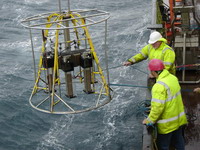
|
The
megacorer with its catch of sediment |
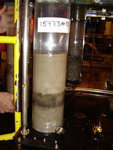
|
Sediment
core from M5. Notice
the black band, which is an occasional feature of cores
collected here. This material is probably a lens of
volcanic sand that has washed down-slope form the island |
|
Click on the pictures
for a larger version. Opens in new window/tab |
The sediments are not really typical abyssal
sediments and even at 4000 m water depth, they do seem to
be influenced by the Crozet Platform, a very large volcanic
mountain which rises steeply from the sea bed and expresses
itself above sea level as the Crozet Islands. In our trawls,
we have picked up fairly sizable pieces of pumice, which presumably
derive from previous eruptions, but there are also pockets
of volcanic sand/gravel which has probably been eroded from
the islands and tumbled down the slope to settle in patches
in the deep water. There have also been plenty of rounded
volcanic pebbles in our trawls, which probably come from the
Crozet beaches or sub tidal zones. Some of these have had
kelp (seaweed) stalks attached to them, which gives us another
clue as to where they come from.
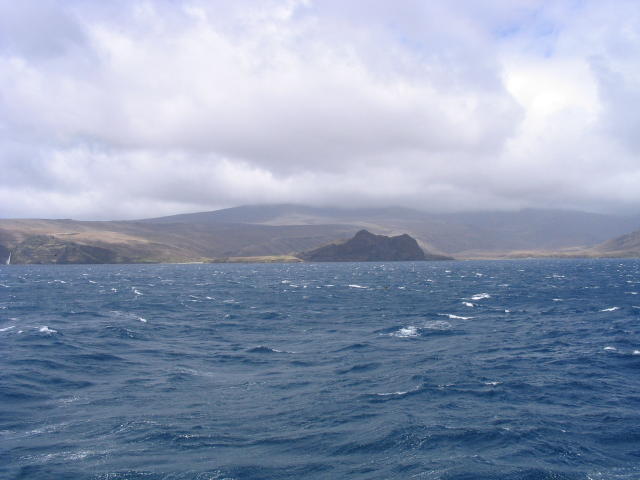
The Crozet Islands – looking appealing!
So, what is the interest in what really is a
pile of mud? Firstly it is to sample and study the organisms
from bacteria, through meiofauna (less than 0.5 mm) to macrofauna
(less than 10 mm) and to understand their community structure
and diversity. Secondly it is to study the chemistry of the
organic material through the sediment. One of the main issues
that we are trying to investigate is whether or not the organic
chemicals contained in the phytodetritus arriving at the sea
floor influence the types of animals living here. Deep-sea
animals require certain vitamins and if they do not have a
supply of these (in the phytodetritus) then it seems likely
they won’t do well.
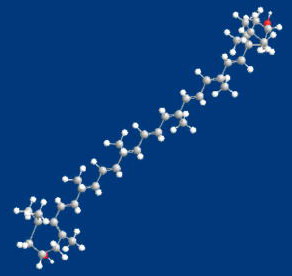
3-D chemical structure of zeaxanthin, a molecule made
up of carbon (grey), hydrogen (white) and oxygen (red).
This compound, a carotenoid similar to Vitamin A, is
biosynthesised only by photosynthesising organisms,
but it and its relatives may be important vitamins for
other animals. For example zeaxanthin may have a role
to play in protecting the eggs and larvae of some holothurians. |
|
In order to assess the
importance of the chemistry of material arriving at
the sea floor to the animals that live there, we have
been using sediment traps and pumps to collect phytodetritus.
It is also useful for us to study the profiles in the
sediments of the organic chemicals, so we can determine
how quickly they are taken up by the sedimentary community
and also how they are transformed. We can’t do
this on the ship, so we carefully slice the sediment
cores and freeze the sections at -80°C so that they
can be transported home and analysed in our laboratories.
This is a long and painstaking process and it will probably
be at least a year before we have enough data to say
that we have a molecular picture of the Crozet sedimentary
environment! Chemists have a hard time on cruises –
they watch everyone else getting fantastic knowing that
it is going to take them ages to get theirs! |
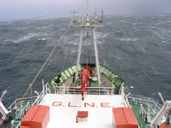 |